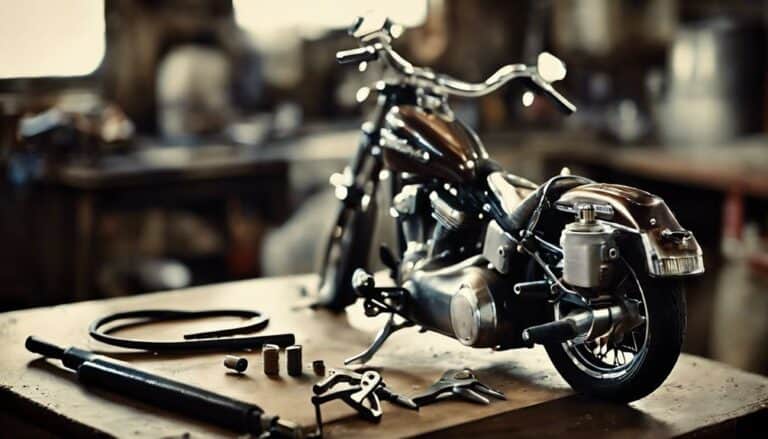When tackling the replacement of a 2009 Harley Davidson fuel pump, think of it as unraveling a complex puzzle where each piece must fit precisely. As you delve into the process, you'll encounter intricate steps that demand attention to detail and a methodical approach.
However, understanding the intricacies of this task can save you time, money, and potential headaches down the road. Stay tuned to uncover the essential tips and tricks that will guide you through the seamless replacement of your Harley Davidson's fuel pump.
Key Takeaways
- Disconnect power sources and purge fuel before removing the old fuel pump.
- Securely install the new fuel pump following proper alignment and connection steps.
- Test the new fuel pump for pressure, voltage, and leaks to ensure correct operation.
- Complete the replacement process by reassembling parts, checking for tight connections, and adhering to maintenance guidelines.
Preparing for the Replacement
To begin preparing for the replacement, start by disconnecting the gray plug to prevent any potential electrical issues. Prioritize safety precautions by ensuring the power source is off before proceeding. Purge fuel from the lines to prevent spills and maintain a safe working environment. Removing the seat and saddle bags will grant you access to the fuel pump area, enabling you to work efficiently.
Next, access the fuse box to disconnect power sources before starting the replacement. This step is crucial in preventing any electrical mishaps during the process. By following these procedures, you're actively reducing the risk of accidents and ensuring a smooth replacement process.
Additionally, clean the dash panel to prevent debris from entering the fuel system during the replacement. Debris prevention is essential to maintain the integrity of the fuel system and prevent any potential damage. By taking these precautions, you're setting yourself up for a successful fuel pump replacement on your 2009 Harley Davidson.
Removing the Old Fuel Pump
Start by disconnecting the negative battery cable to ensure safety and prevent any electrical mishaps during the removal process.
- Loosen and remove the rear tank bolt using a 3/8-inch socket to access the fuel pump.
- Utilize a specialty tool to turn the fuel pump counter-clockwise for removal from the tank.
- Carefully disconnect the main fuel line and electrical connections attached to the fuel pump.
- Troubleshooting issues: If facing difficulty removing the fuel pump, ensure the tank is adequately supported and try gently rocking the pump back and forth while pulling.
- Once all connections are detached, lift the old fuel pump out of the tank, ensuring no residual fuel spills inside.
Removing the fuel pump can sometimes pose challenges, but with proper precautions and attention to detail, you can successfully disconnect the old pump from your Harley Davidson motorcycle. Be mindful of the connections and follow each step meticulously to avoid any troubleshooting issues during the removal process.
Installing the New Fuel Pump
After aligning the new fuel pump carefully in the tank, proceed to securely connect the main fuel line to prevent leaks or malfunctions. Ensure the fitment is correct before proceeding.
Once the main fuel line is connected, secure the float bracket and wires in their designated positions inside the tank for proper operation. Double-check that all components are correctly placed and connected within the fuel pump assembly before sealing the tank.
Rotate the fuel pump assembly clockwise to lock it in place effectively, completing the installation process. Securing connections is crucial to avoid any potential issues with the fuel pump's functionality.
Testing the Fuel Pump
Before proceeding with testing the fuel pump, ensure that the new fuel pump has been securely installed in your Harley Davidson motorcycle's tank following the proper alignment and connection procedures outlined in the previous section.
To effectively test the fuel pump, follow these steps:
- Use a fuel pressure gauge to check the pressure output of the fuel pump.
- Verify that the fuel pressure reading is consistent and falls within the manufacturer's specified range.
- Monitor the voltage and current draw of the fuel pump to confirm its proper function.
- Listen attentively for any unusual noises or vibrations that may indicate issues during testing.
- Perform a leak-down test to assess if the fuel pump can maintain pressure adequately.
Final Steps and Tips
Ensure all components are securely fastened and all connections are double-checked before proceeding with the final steps of the fuel pump replacement process. Ensuring tight connections is crucial to prevent any fuel leaks or malfunctions.
Proper cleaning techniques should be employed to remove any dirt or debris around the area to maintain optimal performance.
Once all connections are secure and clean, reassemble any parts that were removed during the replacement process, such as the seat, saddlebags, and side covers. Make sure everything is tightly secured to avoid any potential hazards while riding.
After everything is back in place, it's time to test the fuel pump to confirm it's working correctly and there are no leaks. Following these final steps diligently will help ensure the successful replacement of the fuel pump in your Harley Davidson motorcycle.
Remember to adhere to manufacturer guidelines for maintenance and replacement to keep your bike running smoothly.
Conclusion
In conclusion, replacing the fuel pump on a 2009 Harley Davidson involves careful preparation, disassembly, replacement, and reassembly of components.
By following the outlined steps and adhering to safety precautions, you can successfully install a new fuel pump and ensure optimal performance of your motorcycle.
Remember to conduct final checks, test the fuel pump, and double-check all connections to guarantee a smooth and efficient replacement process.
Ride on with confidence knowing your fuel system is in top condition.

